In 1982, the U.S. Mint changed the composition of the Lincoln Memorial cents due to rising copper prices. The coins transitioned from solid copper to a copper-plated zinc composition. As a result, the 1983 penny became the second year of issue to feature this new metal combination.
Regular strike 1983 pennies were minted in large quantities at both the Philadelphia (no mint mark) and Denver (“D” mint mark) facilities. The San Francisco Mint produced proof coins for collectors. While most 1983 pennies are common and hold little more than face value, certain rare error coins can be worth thousands of dollars.
1983 Penny Value Chart
| Condition | 1983 No Mint Mark | 1983-D | 1983-S (Proof) |
|---|---|---|---|
| AU | — | — | — |
| MS65 | $0.36 | $0.36 | — |
| PR65 | — | — | $3.54 |
History of the 1983 Penny

Abraham Lincoln and the Lincoln Cent
Abraham Lincoln, the 16th President of the United States, began his career as a lawyer and entered politics at a young age. He was first elected President in 1861 and was reelected in 1864.
He is most renowned for issuing the Emancipation Proclamation, a pivotal move toward ending slavery. Additionally, Lincoln established a national banking system to stabilize the post-war economy. Sadly, his second presidential term was cut short by his assassination in 1865.
To honor the centennial of his birth, the first Lincoln cents were released in 1909. These coins were designed by Victor D. Brenner, whose obverse design featuring Lincoln’s portrait remains in use today.
1983 Lincoln Cent Types & Mintage Figures
| Location | Type | Mintage |
|---|---|---|
| Philadelphia | 1983 No Mint Mark | 7,752,355,000 |
| Denver | 1983-D | 6,467,199,428 |
| San Francisco | 1983-S (Proof only) | 3,279,126 |
| Total | — | 14,222,833,554 |
Reverse Design Changes Over Time
In 1959, to mark Lincoln’s 150th birthday, the reverse of the penny was redesigned by Frank Gasparro, replacing the wheat ears with the Lincoln Memorial. This made the cent unique, as Lincoln appeared on both sides of the coin—a first in U.S. coinage history. These coins became known as Memorial reverse cents and were used until 2008.
In 2009, the U.S. Mint released four bicentennial reverse designs depicting different phases of Lincoln’s life:
- Birth and Early Childhood – Log cabin in Kentucky
- Formative Years – Lincoln reading while taking a break from rail splitting
- Professional Life – Lincoln as a young lawyer in Illinois
- Presidency – The U.S. Capitol dome under construction
Lincoln Penny Composition Overview
- 1909–1982: 95% copper, 5% zinc (except for 1943 wartime steel cents made of zinc-coated steel)
- 1982 (Transition Year): Both copper and copper-plated zinc cents were minted
- 1983–present: Copper-plated zinc (97.5% zinc, 2.5% copper coating)
The shift to zinc in 1982 occurred because the cost of copper exceeded the coin’s face value, making it economically unsustainable for the U.S. Mint.
The 1983 Penny Features
The obverse of the 1983 Penny
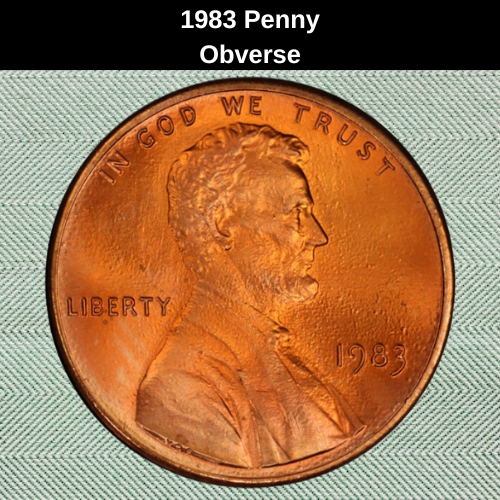
In 1909, renowned sculptor Victor D. Brenner designed the obverse (front) of the new Lincoln cent. The design prominently features a right-facing bust of President Abraham Lincoln, the first real person ever depicted on a U.S. coin intended for general circulation.
At the top of the coin appears the national motto “IN GOD WE TRUST.” The word “LIBERTY” is inscribed to the left of Lincoln’s profile, positioned behind his neck. The date—for example, 1983—is placed to the right of Lincoln’s chest.
If applicable, a mint mark (either “D” for Denver or “S” for San Francisco) appears just below the date. On some issues, especially earlier ones, the designer’s initials “V.D.B.” can be found at the bottom rim of the coin, near Lincoln’s shoulder.
The reverse of the 1983 Penny
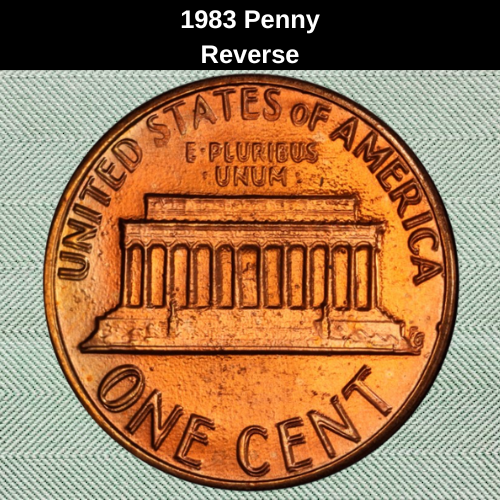
The reverse design of the Lincoln cent was introduced in 1959 to commemorate the 150th anniversary of Abraham Lincoln’s birth. The U.S. Mint replaced the previous wheat ears design with a new image created by Frank Gasparro, featuring the Lincoln Memorial at the center.
This iconic reverse not only showcases the Memorial in detail but also includes a small representation of the Lincoln statue inside—making this coin the first U.S. coin to depict the same person on both sides.
Above the Memorial is the motto “E · PLURIBUS · UNUM”, while the denomination “ONE CENT” is inscribed below. The words “UNITED STATES OF AMERICA” arc along the top rim of the coin, framing the design. Gasparro’s initials “FG” are subtly placed to the right of the Memorial, near its base.
1983 Lincoln Penny Specifications
| Feature | Detail |
|---|---|
| Face Value | 1 cent (USD $0.01) |
| Diameter | 19.05 mm (0.75 inches) |
| Thickness | 1.52 mm (0.0598 inches) |
| Weight | 2.5 grams (0.0705 oz) |
| Edge | Plain |
| Shape | Round |
| Composition | 97.5% zinc, 2.5% copper (copper-plated zinc) |
Despite its minimal copper content, the 1983 penny maintains a coppery appearance due to its thin outer copper plating. Over time, the coin’s color may vary—ranging from bright red to reddish-brown or even darker tones—depending on oxidation, circulation wear, and storage conditions.
Additional Features of the 1983 Lincoln Penny
The 1983 Lincoln one-cent coin is round with a plain edge. It measures 19.05 mm (0.75 inches) in diameter and 1.52 mm (0.0598 inches) in thickness. The coin weighs approximately 2.5 grams (0.0705 ounces).
Composed of 97.5% zinc with a 2.5% copper plating, this penny marked the second full year of the U.S. Mint’s transition from bronze to copper-plated zinc cents. Despite the minimal copper content, the outer layer provides a visually appealing finish. These coins display a range of natural color variations—from bright red (indicative of mint state coins) to brown (from oxidation and circulation).
This plating not only preserves the coin’s traditional copper appearance but also serves as a practical response to rising copper prices in the early 1980s.
Grading the 1983 Lincoln Penny
Coin grading is the process of evaluating a coin’s condition and quality—key factors in determining its market value. Coins can range from heavily worn (POOR) to flawless (MINT STATE 70). The better the condition, the more valuable the coin typically is.
Coins that show wear from circulation fall within the circulated grades, ranging from Good (G) to Extremely Fine (EF or XF). On the other hand, coins with no signs of wear—retaining their original mint luster—are classified as uncirculated or Mint State (MS) coins.
Common factors that affect grading include:
- Surface wear
- Scratches, dents, or corrosion
- Mint luster and strike quality
- Presence and clarity of mint marks
Standard Coin Grading Scale
| Grade Code | Grade Name | Description |
|---|---|---|
| 1 | Basal State-1 (PO) | Heavily worn, barely identifiable |
| 2 | Fair (FR) | Very worn, details nearly gone |
| 3 | Very Fair (AG) | Some design visible, but very flat |
| 4–6 | Good (G) | Major features visible, heavy wear |
| 7–10 | Very Good (VG) | Moderate wear, more detail visible |
| 12–15 | Fine (F) | Moderate to light wear |
| 20–30 | Very Fine (VF) | Light wear, strong design elements |
| 40 | Extremely Fine (EF) | Very light wear on high points |
| 50 | About Uncirculated | Traces of wear, nearly full mint luster |
| 60 | Mint State (MS60) | No wear, average strike and luster |
| 65 | Mint State (MS65) | Sharply struck, high-quality luster |
| 70 | Mint State (MS70) | Perfect coin, no visible flaws under 5x magnification |
Tip: For collectors, knowing the grade of your coin is essential to assessing its true value. Refer to our detailed grading guide to match your coin’s condition with the appropriate grade on the Sheldon Scale.
The 1983 Penny Value Guides
1983 No Mint mark Penny Value
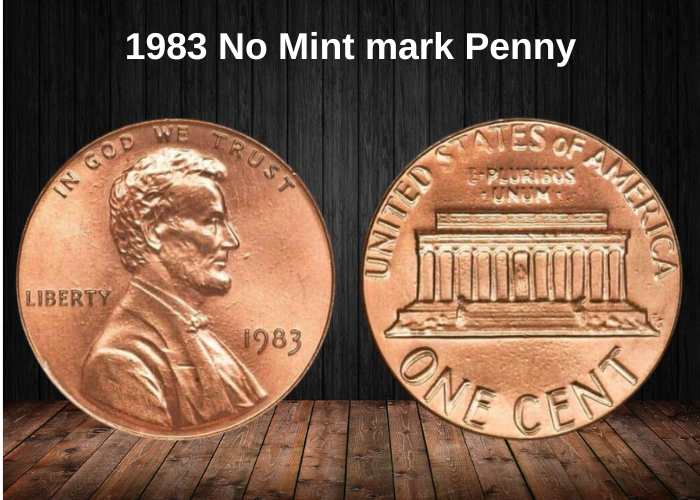
The Philadelphia Mint produced an impressive 7,752,355,000 Lincoln cents in 1983. While these coins are common in circulated grades, uncirculated examples—especially in higher grades—can carry notable collector value.
Below is a breakdown of the estimated market values for 1983 pennies from Philadelphia in various Mint State (MS) conditions:
| Grade | Estimated Value |
|---|---|
| MS 63 | $5 |
| MS 64 | $9 |
| MS 65 | $14 |
| MS 66 | $20 |
| MS 67 | $55 |
| MS 68 | $550 |
Note: While the MS68 grade is exceptionally rare, it commands a premium in the collector market. In October 2020, one such example sold at auction for $410, reflecting how auction prices may vary from catalog estimates depending on demand, eye appeal, and certification.
1983 S Penny Value
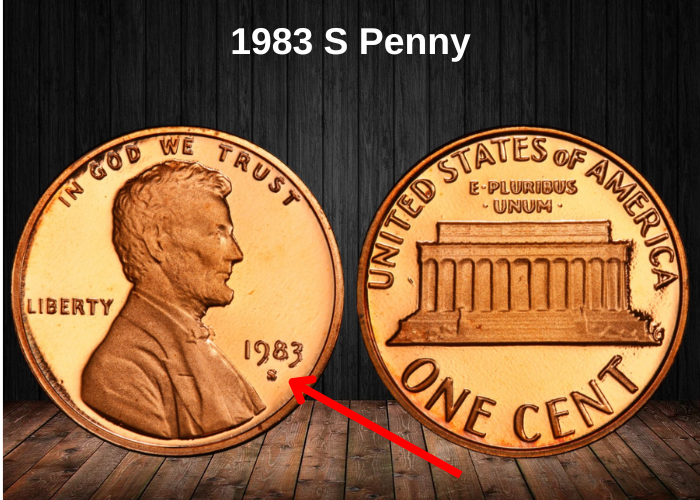
The San Francisco Mint struck 3,279,126 proof Lincoln cents in 1983, all designated with the “S” mint mark. These coins were made specifically for collectors and never intended for circulation.
Most 1983-S proof pennies available on the market today fall between PR60 and PR63, and typically sell for around $2. Higher-grade proofs, however, are valued more significantly by collectors.
Value Chart for 1983-S Proof Lincoln Cents
| Grade | Estimated Value |
|---|---|
| PR 64 | $3 |
| PR 65 | $4 |
| PR 66 | $5 |
| PR 67 | $6 |
| PR 68 | $7 |
| PR 69 | $20 |
| PR 70 | $800 |
Notable Sale: In January 2004, a flawless PR70 Deep Cameo example sold for $800 at Heritage Auctions, making it one of the most valuable 1983 proof cents known.
1983 D Penny Value
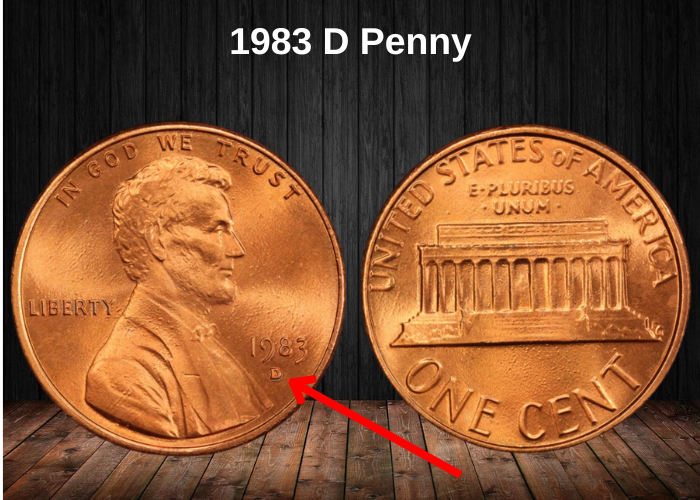
In 1983, the Denver Mint produced a massive 6,467,199,428 Lincoln cents, most of which are still common in lower grades. These coins are made of copper-plated zinc, following the 1982 composition change.
Basic MS60 red specimens of the 1983-D penny are valued around $0.10, but as the grade improves, so does the coin’s value significantly.
Value Chart for 1983-D Lincoln Cents
| Grade | Estimated Value |
|---|---|
| MS 63 | $5 |
| MS 64 | $8 |
| MS 65 | $16 |
| MS 66 | $22 |
| MS 67 | $30 |
| MS 68 | $325 |
Auction Highlight: In December 2014, a MS68 RD specimen fetched $329 at auction, reflecting the high demand for premium-grade examples.
Rare 1983 Penny Error list
Doubled die reverse
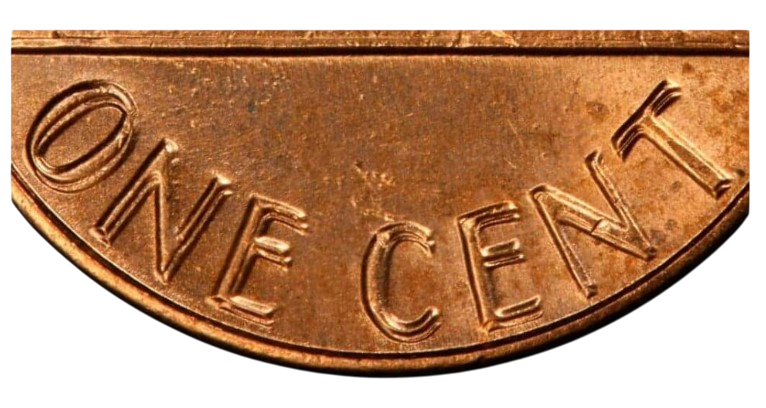
One of the most notable and sought-after errors in the 1983 Lincoln cent series is the Doubled Die Reverse (DDR). This variety emerged due to a flaw in the hubbing process, where a misalignment between the working hub and the die caused a visible doubling of elements on the reverse of the coin.
What to Look For:
Collectors should focus on the lettering on the reverse, particularly:
- E PLURIBUS UNUM
- UNITED STATES OF AMERICA
- ONE CENT
The doubling effect on these inscriptions can range from subtle to dramatic. The more pronounced the doubling, the higher the coin’s value.
Value Highlights:
- Common DDR examples in MS65 Red can sell for hundreds of dollars, depending on the clarity of the doubling.
- A premium-grade specimen—MS68 Red DDR—sold for $7,050, showcasing how valuable this error can be in top condition.
Doubled die obverse
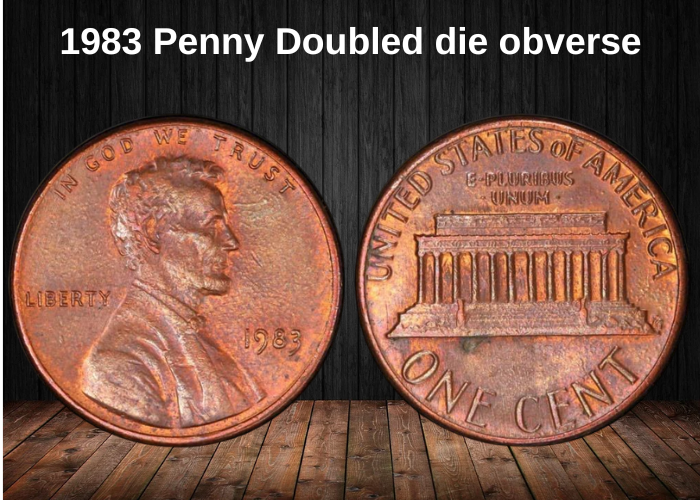
Similar to the Doubled Die Reverse, the Doubled Die Obverse (DDO) occurs due to a misalignment during the hubbing process, where the working die receives an extra, slightly offset impression from the hub.
Where to Spot the Doubling:
In the 1983 Lincoln cents, DDO examples typically show visible doubling on:
- The date (1983)
- The inscriptions “IN GOD WE TRUST” and “LIBERTY”
While this error is striking, DDO coins from 1983 are more common than their DDR counterparts, which makes them less valuable on the market.
Value Insight:
- Depending on the grade and intensity of the doubling, most 1983 DDO cents fall within a modest value range, especially in circulated condition.
- Higher-grade examples with strong doubling can still attract collector interest, though not at the same premium level as the DDR variety.
Cent struck on a bronze planchet
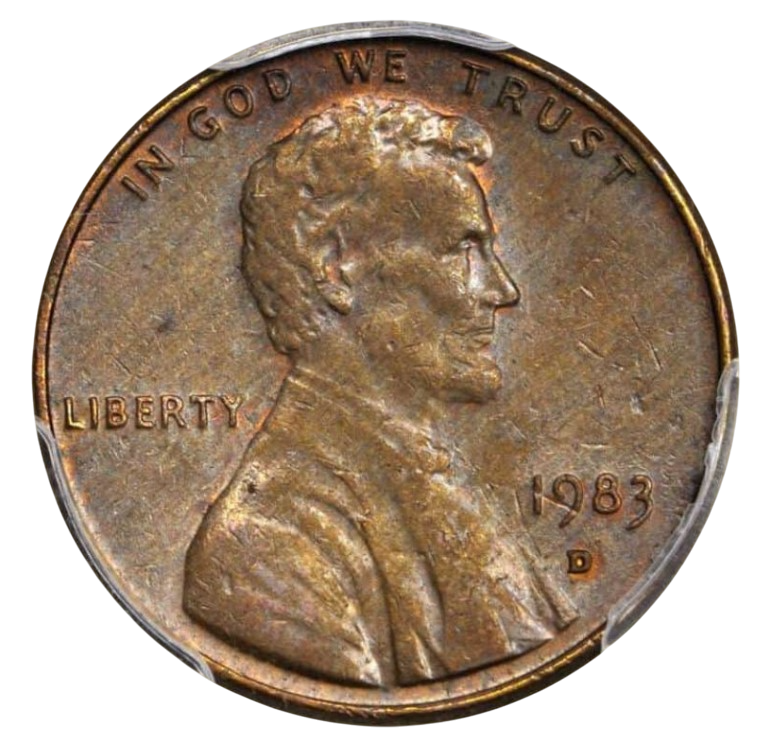
In 1983, regular Lincoln cents were struck on copper-plated zinc planchets weighing approximately 0.088 ounces (2.5 g). However, a rare and fascinating mint error occurred when a bronze planchet, used prior to the 1982 composition change, was mistakenly fed into the press.
Why It’s Special:
These bronze planchets contain 95% copper and 5% tin/zinc, resulting in a coin that weighs about 3.11 g—noticeably heavier than the standard 2.5 g zinc cents.
Collector Appeal:
- These error coins are extremely scarce and highly sought after by numismatists.
- The difference in weight and metallic composition makes them easy to identify with a precise scale.
- Due to their rarity, these coins can fetch hundreds or even thousands of dollars, depending on condition and certification.
Cent struck on a copper planchet
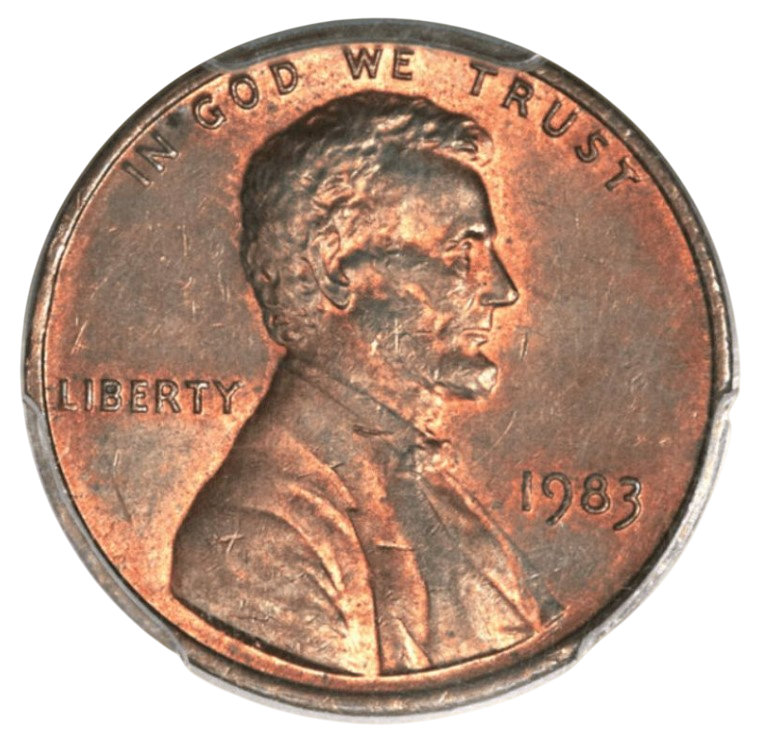
This rare error occurred when a 1983 cent was mistakenly struck on a bronze planchet rather than the intended copper-plated zinc planchet. Since the U.S. Mint officially transitioned to zinc in 1982, only a few of these bronze-struck 1983 pennies exist, making them exceptionally scarce and highly collectible.
How to Identify This Error:
The quickest and most reliable method is to weigh the coin:
- Standard 1983 cent (zinc): 2.5 g (0.088 oz)
- Bronze error cent: Approximately 3.11 g (0.109 oz)
If your 1983 penny weighs significantly more than 2.5 grams, you may be holding one of these rare transitional errors.
Cent struck on an un-plated planchet
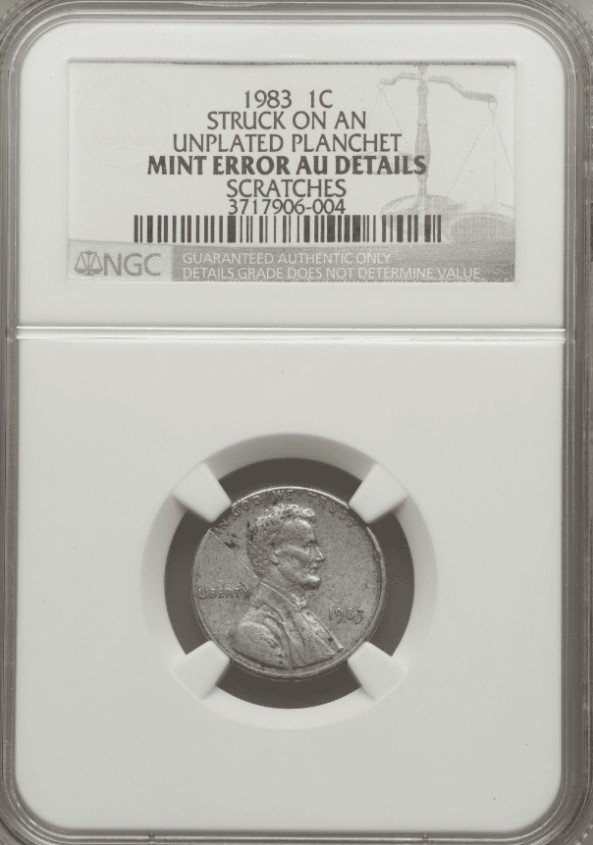
Unlike previous minting errors involving the wrong metal composition, this error features a coin struck on the correct planchet material—but with missing copper plating. These 1983 Lincoln cents were accidentally struck on raw, unplated zinc planchets, resulting in a noticeably lighter or silvery surface rather than the typical reddish-brown hue.
Key Identifiers:
- Silvery or grayish color instead of copper tones
- Same weight as standard 1983 cents: approximately 2.5 g (0.088 oz)
- Often shows rougher or duller texture due to the lack of smooth copper plating
These errors are relatively uncommon and popular among collectors due to their distinct appearance.
Where to sell your penny?
Now that you know the value of your penny, you might be wondering where to sell it. Don’t worry: here’s a guide to some of the best online platforms where you can easily sell your coins, along with their advantages and disadvantages.
Discover the best platforms for selling coins online (pros and cons).
FAQ about the 1983 Penny
1. Why is the 1983 penny important to collectors?
The 1983 penny is notable because it’s the first full year where all cents were struck on the copper-plated zinc planchet (97.5% zinc, 2.5% copper). This makes it significant as the U.S. fully transitioned away from the heavier bronze alloy used until mid-1982.
2. What is the composition and weight of a 1983 penny?
- Composition: Copper-plated zinc
- Weight: Approximately 2.5 grams
This lighter weight is a key identifier if you’re checking for rare transitional errors (like bronze planchet coins mistakenly struck in 1983).
3. What is the value of a regular 1983 Lincoln cent?
Most 1983 cents are very common and have a value of 1 cent in circulated condition. However:
- In uncirculated MS65+ condition, they can be worth $0.25 to $5.
- Red (RD) examples graded MS67 or higher can fetch $50 to $150 or more, especially from PCGS or NGC.
4. What is the 1983 doubled die reverse penny and why is it valuable?
This is the most famous and valuable variety of the year.
- The 1983 Doubled Die Reverse (DDR) shows strong doubling on the reverse lettering, especially on:
- “ONE CENT”
- “UNITED STATES OF AMERICA”
- “E PLURIBUS UNUM”
💰 Value:
- Circulated DDR examples: $100–$300+
- MS65 DDR: $500–$1,000+
- MS66–MS67 DDR: $2,000–$5,000+ at auction
Authenticity is key—many fakes exist.
5. Does the 1983 penny have any known transitional errors?
Yes. A 1983 Lincoln penny struck on a bronze planchet (should have been discontinued in 1982) has been found and is extremely rare.
- Correct weight: 3.11 grams (instead of 2.5g)
- These transitional error coins can sell for $10,000–$20,000+, depending on grade and authentication.
These are known as off-metal errors and must be confirmed by weight and professional grading.
6. Were 1983 pennies struck at multiple mints?
Yes. The 1983 Lincoln penny was struck at:
- Philadelphia (no mint mark)
- Denver (D mint mark)
There are no proof pennies dated 1983, as they were only minted in San Francisco starting again in 1984.
7. Should I get a 1983 penny graded?
Consider grading if your coin is:
- A confirmed Doubled Die Reverse (DDR)
- In exceptional uncirculated condition (MS67 RD+)
- A suspected bronze planchet transitional error
- An unusual error coin (e.g., off-center strike, broadstrike, etc.)
For normal circulated coins, grading is not financially worthwhile.


















































